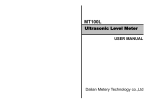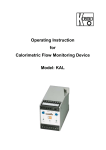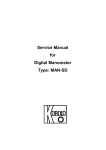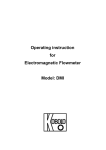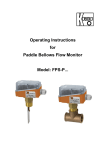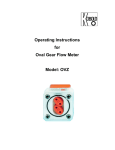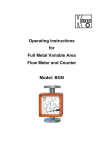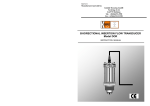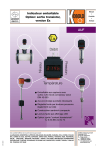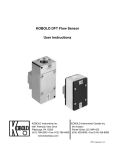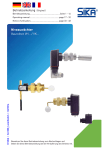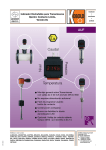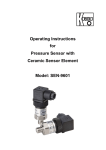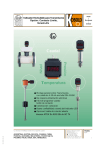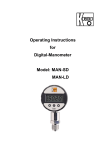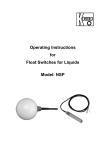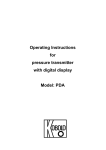Download Service Manual for Flow Meter / Monitor Typ: DSV-
Transcript
Service Manual for Flow Meter / Monitor Typ: DSV-... DSV 1. Contents 1. 2. 3. 4. 5. 6. 7. 8. 9. 10. 11. 12. 13. 13 Instructions ......................................................................... 3 Contents ............................................................................. 2 Suggested Application........................................................ 3 Operating Principles ........................................................... 4 Instrument Inspection ......................................................... 4 Mechanical connection ....................................................... 5 Electrical connection........................................................... 6 Commission of Unit ............................................................ 7 Maintenance ....................................................................... 8 Technical Data.................................................................... 9 Ordering Codes ................................................................ 10 Dimensions....................................................................... 11 Recommended Spare Parts ............................................. 11 Declaration of Conformance............................................. 12 Manufactured and sold by: Kobold Messring GmbH Nordring 22-24 D-65719 Hofheim Tel.: +49(0)6192-2990 Fax: +49(0)6192-23398 E-Mail: [email protected] Internet: www.kobold.com Seite 2 DSV 12/02 DSV 2. Instructions Please read this operating instruction carefully before unpacking and set-up. These devices may be used, maintained and installed only by personnel, who are familiar to work with operating instructions and can observe appropriate safety measures. PED 97/23/EG In acc. with Article 3 Paragraph (3), "Sound Engineering Practice", of the PED 97/23/EC no CE mark. Table 8, Pipe, Group 1 dangerous fluids 3. Suggested Application These units of type DSV are employed for measurement and monitoring of flow of liquids. Only those liquids may be measured which are homogeneous, free from impurities and have low viscosity. Also, they must withstand against materials used in fabrication of these units. Media, having high viscosity can introduce considerable measurement errors (partly). Large dust particles can block the float, resulting in error-messages and erroneous measurements. Also, ferrite particles, which deposit on the embedded magnets of float, can trigger the same effect. To overcome this problem, installation of a magnetic filter is recommended. The units are provided as follows: Flow measurement The reading of current flow takes place on the spot. Top edge of the float displays the flow directly in l/min (water) on the scale attached to the graduated measuring glass. Limit-contacts (only with type DSV-2... and DSV-3...) With a view to monitor the flow values, all units are provided with one or two adjustable limit-contact(s). Standard version: Special version: Special version: Normally Open function (with increasing flow) Switch-over function Ex-contact N.O., Ex-contact switch-over To a large extent, the contact is adjustable (over the entire measuring range), while giving due consideration to hysteresis. DSV 12/02 Seite 3 DSV 4. Operating Principles The flow meter and monitor of type DSV operate according to the famous principle of float flow metery, though, without using generally employed extended conical measuring tube. These patented units incorporate instead a cylindrical lead-pipe, which has a slit along the periphery of the cone. Inside this lead-pipe, a float is situated which lifts up as the liquid rushes into the pipe. Every float position corresponds to a definite flow value, which can be read from scale attached to the measuring glass. Inside float element, permanent magnets are embedded, which energise a protective gas contact (Reed Switch). The triggering of contact takes place in a non-contacting fashion (through magnetic force) i.e. the contact is hermetically separated from entering medium. 5. Instrument Inspection These devices are examined before dispatch and sent away in perfect condition. Should damage to a device be visible, then we recommend an exact check of the delivery packing. In case of damage please inform the postal service/forwarding business immediately, since they hold the responsibility for any damages during transit. Scope of delivery Scope of delivery applies to all parts assembled within the unit. Seite 4 DSV 12/02 DSV 6. Mechanical connection Before installation: · Make sure that the permitted max. operational pressure and temperature limits are not exceeded (see Ch. 10 Technical Data) · The installation of the unit is rendered vertically in the piping scheme. The flow should take place from bottom to top. · Remove all transport safety locks and ensure that no remains of packing material reside inside the unit. · The sealing of union fittings is carried out through Teflon band or similar material. · During installation of these devices, attention must be paid to the ascertain that no large course or pressure-load is exercised on the union fittings. We recommend to fasten the inlet and outlet line at approx. 50 mm distance mechanically, from the union fittings. · The units may not be installed at a location within an inductive field. Note! The union fittings of these devices must be held fixed by means of a suitable fork-wrench while screwing in. Otherwise stresses will transfer to the housing which may lead to the destruction of graduated measuring glass. · If possible, it should be checked after mechanical installation whether the connections between union fittings and pipes are properly sealed Attention! While installing in a free and open environment, please pay attention to the fact that the freezing of medium can destroy the measuring tube. DSV 12/02 Seite 5 DSV 7. Electrical connection (Only for type DSV-2... and DSV-3...) · Ascertain, that the electric supply lines are not active. · Loosen the stopping screw of plug-cap and draw off the cap (crown) from plug-base. · Assemble the power lines inside plug-cap, according to the adjoining connection diagram. · If the contact is not adjusted yet, this should be done for good reason at this point. · (see Ch. 8 - "Commissioning"). · Place the plug on the contact base and f t it ith th f t Note! The given electrical parameters of contact may not be exceeded individually, even for a brief period of time. For higher switching values, we recommend a protective contact relay or some other contact protection measure. After connecting the limit contact with the external devices you wish to incorporate within the system and adjusting the desirable switching points all connection work is completed. The unit can now be put into operation. Seite 6 DSV 12/02 DSV Example for protective contact measures. For capacitive and inductive loads (long conductors and relays/contactors), we recommend that you use protective contact relays or make use of protective circuits. 8. Commission of Unit Application in machines, according to guidelines 89/392/EWG, the commissioning of these units is barred till it is determined that the machine is in agreement with the designations of guidelines. Adjustment of limit-values · Loosen both the safety screws on the contact base, with the help of a screw driver. · Dislocate the contact base till lower catch. · Remove the plug-cap after loosening the safety screws. · Connect with PIN 1 + 2 (toggle contact PIN 2 + 3) a suitable circuit test unit. Attention! Sudden opening of the supply can lead to pressure peaks, which repeatedly exceed the operating pressure (Water hammer!) This can lead to the breakage of the measuring glass. DSV 12/02 Seite 7 DSV Case 1: Device in circuit Open the supply line. Let the medium flow slowly, till the Top edge of the float shows the flow Volume of desired switching point. Case 2: Device outside circuit Raise the float with a suitable tool, till the top edge of the float shows the desired flow volume of desired switching point. · The reed contact is now closed (electrically closed-circuit). · Dislocate switch-housing upwards, till the reed-contact is just open (no electrical passage). The contact is now adjusted for decreasing flow. If the contact needs to be adjusted for increasing flow, it must be relocated now around the hysteresis about 3-5 mm downwards. · Adjust the safety screws in this position by tightening them. Put on plug-cap. The unit is ready for operation. · The correct adjustment of limit-contact has the bistable switching behaviour; i.e. on exceeding the adjusted limit, contact remains closed and below the adjusted limit, contact stays open. Hysteresis Hysteresis reflects the difference between switch-on and switch-off points of contact. Through standard tuning of magnet and contact pith (AW number) a hysteresis of about 3-5 mm float stroke is achieved. Thereby, simultaneously ensuring that the contact exhibits bistable behaviour. Transgression of measuring range Attention! Continuous violation of measuring range by pulsating flow and thereby resulting jerks of float on the limit-pin can lead to increasing wear and damage to the unit. In such a case, please consult your supplier. Non-pulsating flow can essentially exceed the measuring range, merely resulting in a notable increase in pressure-loss. (Permitted max. operational pressure not to be transgressed) 9. Maintenance In case, the medium to be measured is free from impurities, the units of type DSV are almost maintenance free. If lime or other deposits on measuring glass or within interior parts develop, the units should be cleaned on a regular basis. After removing the upper grub-screw, screw joint can be withdrawn from the unit, and the inner parts can be extracted for cleaning. The measuring glass can be cleaned with the help of a suitable brush. After cleaning, the unit must be assembled in the correct sequence. Seite 8 DSV 12/02 DSV 10. Technical Data Housing: Connections: Float: Orifice: Measuring glass: Sealings: Max.temperature: Max. pressure: Accuracy: Mounting position: Weight: Pressure loss: Aluminium anodised (no contact with Medium) DSV-x1..: Brass MS 58, Ni-plated DSV-x2..: St. Steel 1.4301 see Ch. 11 Dimensions DSV-x1..: Brass MS 58, Ni-plated DSV-x2..: St. Steel 1.3955 Duran 50 (Borosilicate glass) DSV-x1..: Perbunane DSV-x2..: Viton 100 °C (Metal-float) 70 °C (PP or PVDF float) 10 bar ± 4% (F.S.) vertical, flow from bottom see Ch. 11 Dimensions see Ch. 11 Dimensions Contacts (DSV-2..., DSV-3...) Electrical Switching parameters N.O contact (CSA) max. 240 VAC / 100 VA / 1.5 A Changeover contact (CSA) max. 240 VAC / 60 VA / 1 A N.O. EEx d llC T6 max. 250 VAC / 80 VA / 2 A Changeover EEx d llC T6 max. 250 VAC / 60 VA / 1 A N.O. EEx ia l BVS. (Mining) max. 250 VAC / 100 VA / 1.5 A Changeover EEx ia BVS (Mining) max 220 VAC / 60 VA / 1A Electr. Connection: Plug DIN 43 650 Except DSV-..E..; DSV-..X..: 1.5 m cable Protection cat.: IP 65 DSV 12/02 Seite 9 DSV 11. Ordering Codes Seite 10 DSV 12/02 DSV 12. Dimensions Type SW G L (mm) D (mm) DSV-..01H DSV-..02H DSV-..03H DSV-..04H DSV-.. 05H DSV-..06H DSV-..O7H DSV-..08H DSV-..09H 32 32 32 32 32 41 41 41 46 ¼(½) ¼(½) ¼ ( ½) ½(¾) ½(¾) ¾ (1) ¾ (1) 1 1¼ 161 (165) 161 (165) 161 (165) 165 165 165 (176) 165 (176) 204 222 43 43 43 43 43 48 48 48 55 DSV-1... Weight approx. (kg) DSV-1 DSV-2 DSV-3 0.75 1.0 1.25 0.75 1.0 1.25 0.75 1.0 1.25 0.75 1.0 1.25 0.75 1.0 1.25 1.0 1.25 1.5 1.0 1.25 1.5 1.2 1.45 1.7 1.5 1.75 2.0 DSV-2... dP bar 0.04 0.06 0.04 0.04 0.07 0.08 0.14 0.3 0.4 Float with unit version Brass St.Steel PP PVDF PP PVDF PP PVDF PP PVDF MS Ni-pl. 1.4301 PP PVDF MS Ni-pl. 1.4301 MS Ni-pl. 1.4301 PP PVDF DSV-3... SW 30 30 43 43 SW L L L SW Both edge connection D Both edge connection Both edge connection D D 13. Recommended Spare Parts Only the unit-parts and materials will be listed. Corresponding to the unit type, parts in different sizes are available. (Please ensure you mention the unit type, when ordering spare parts). 1.1) Float Brass 1.2) Float Polypropylene 1.3) Float St. Steel 1.4) Float PVDF 2.1) Slit-orifice Brass 2.2) Slit-orifice St. Steel DSV 12/02 3.1) O-Ring Perbunane 3.2) O-Ring Viton 4.1) Contact (N.O. function) 4.2) Contact (toggle function) 4.3) Ex-contact N.O. 4.4) Ex-contact 4.5) Ex-contact N.O. Mining 4.6) Ex-contact toggle Mining 5.1) Meas. glass with scale Seite 11 DSV 13 Declaration of Conformance We, KOBOLD-Messring GmbH, Hofheim-Ts, Germany, declare under our sole responsibility that the product: Flow Meter / Monitor Type DSV-... is in agreement with the following standards: DIN EN 61010-1 1994-03 Safety requirements for electrical equipment for measurement, control and laboratory use. DIN VDE 0470-1 1992-11 Protection through housing (IP-code) Also the following EWG guidlines are fulfilled: 73/23 EWG Signature: Date: 30.09.02 H. Peters Seite 12 M. Wenzel DSV 12/02












